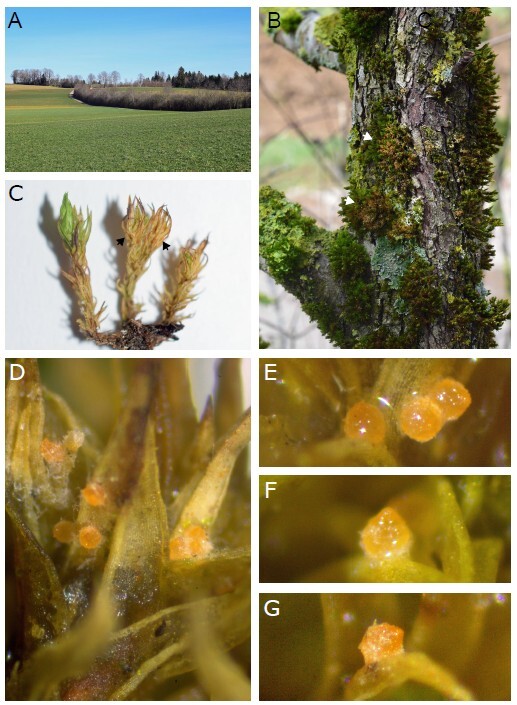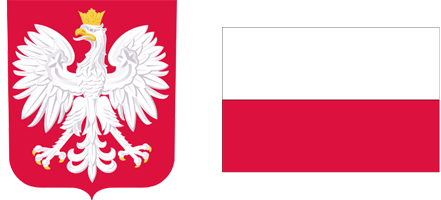ORIGINAL ARTICLE
Bryocentria insolens (Hypocreales) – a new bryophilous ascomycete on Lewinskya and a preliminary phylogenetic analysis of European Bryocentria
1
School of Biological Sciences, University of Bristol, 24 Tyndall Avenue, Bristol, BS8 1TQ, United Kingdom
2
Haut du Village, 42345, La Chaux-des-Breuleux, Switzerland
3
Xaverianenplantsoen 79, BE-2300 Turnhout, Belgium
4
Botanische Staatssammlung München, Menzinger Straße 67, 80638 München, Germany
Submission date: 2025-03-09
Acceptance date: 2025-05-26
Online publication date: 2025-07-03
Publication date: 2025-07-03
Plant and Fungal Systematics 2025; 70(1): 28-37
KEYWORDS
ABSTRACT
The bryophilous genus Bryocentria comprises nineteen species of mostly hepaticolous
parasites exhibiting a range of distinctive ascospore features and host-parasite
interactions. While Bryocentria has been relatively well studied in Europe, with several
common and well-known species, new taxa continue to be encountered and most species
lack molecular data. Here, we describe a new, muscicolous species of Bryocentria and
provide molecular barcoding data for most European species. Bryocentria insolens sp. nov.
parasitizes the mosses Lewinskya affinis and L. speciosa, with records from Switzerland
and Belgium. The new species deviates from most congenerics by parasitising mosses
rather than liverworts, and its ascospores lack the medial, cyanophilous band-like structures
typical of most species in the genus. New molecular data from the LSU locus from
Bryocentria insolens, B. hypothallina, B. metzgeriae and B. cyanodesma are combined with
recent data from B. brongniartii and B. confusa in a preliminary phylogenetic analysis of
the genus. These data support the hypothesis that the sequenced species form a natural
group. Furthermore, they suggest that the distinctive transverse band-like structures in
the medial regions of the ascospores of most Bryocentria species is a trait that arose after
the acquisition of a bryophilous lifestyle by a likely necrotrophic hypocrealean ancestor.
Finally, a key to the European members of the genus is provided to aid with identification.
CONFLICT OF INTEREST
No potential conflict of interest was reported by the author(s).
REFERENCES (25)
2.
Benkert, D. & Krieglsteiner, L. 2006. Octospora affinis (Ascomycetes, Pezizales), a new, apparently not rare bryophilous species on Orthotrichum affine. Zeitschrift für Mykologie 72(1): 53–58.
3.
Blockeel, T. L., Bosanquet, S. D., Hill, M. O. & Preston, C. D. (eds) 2014. Atlas of British & Irish Bryophytes. Pisces publications, Newbury.
4.
Döbbeler, P. 1997. Biodiversity of bryophilous ascomycetes. Biodiversity & Conservation 6(5): 721–738. https://doi.org/10.1023/A:1018....
5.
Döbbeler, P. 1998. Ascomyceten auf der epiphyllen Radula flaccida (Hepaticae). Nova Hedwigia 66(3–4): 325–373. https://doi.org/10.1127/nova.h....
6.
Döbbeler, P. 2004. Bryocentria (Hypocreales), a new genus of bryophilous ascomycetes. Mycological Progress 3(3): 247–256. https://doi.org/10.1007/s11557....
7.
Döbbeler, P. 2005. Three new hypocrealean ascomycetes on bryophytes. Sydowia 57(2): 179–188.
8.
Döbbeler, P. 2006. Ascomycetes on Frullania dilatata (Hepaticae) from Tuscany. Mycological Progress 5(1): 32–40. https://doi.org/10.1007/s11557....
9.
Döbbeler, P. 2010. New species and records of Bryocentria – a hypocrealean genus of bryophilous ascomycetes. Karstenia 50(1): 11–23. https://doi.org/10.29203/ka.20....
10.
Döbbeler, P. 2018. Hypocrealean hyperepiphyllous ascomycetes. Biosystematics & Ecology Series 34: 187–225.
11.
Döbbeler, P. & Davison, P. G. 2017. Frullania as a hotspot for hypocrealean ascomycetes: ten new species from Southeastern North America. Nova Hedwigia 106(1–2). 209–256. https://doi.org/10.1127/nova_h....
12.
Döbbeler, P., Büschlen, A., Eckstein, J. & Gross, A. 2022. Belonium coroniforme Rehm (Helotiales), a highly specialized muscicolous ascomycete on Orthotrichaceae and Leucodon. Sydowia 74: 163–174. https://doi.org/10.12905/0380.....
13.
Döbbeler, P., Linde, J. & Rubio, E. 2018. Bryocentria octosporelloides (Hypocreales) – a new species on Co-lolejeunea minutissima from Asturias (Spain). Ascomycete.org 10(2): 70–80. https://doi.org/10.25664/ART-0....
14.
Gardes, M. & Bruns, T. D. 1993. ITS primers with enhanced specificity for basidiomycetes‐application to the identification of mycorrhizae and rusts. Molecular Ecology 2(2): 113–118. https://doi.org/10.1111/j.1365....
15.
Greiff, G. R. L. & Döbbeler, P. 2024. Endoantria benetecta (Hypocreales) – a new perianthicolous ascomycete on Lejeunea patens in British temperate rainforests. Nova Hedwigia 119(3–4): 351–367. https://doi.org/10.1127/nova_h....
16.
Greiff, G. R. L., Büschlen, A. & Döbbeler, P. 2024. Studies on Bryocentria brongniartii (Hypocreales, Bionectria-ceae) on Frullania dilatata in Europe reveal an anamorph and a cryptic species, B. confusa sp. nov. Ascomycete.org 16(4): 197–204. https://doi.org/10.25664/art-0....
17.
Hou, L. W., Giraldo, A., Groenewald, J. Z., Rämä, T., Summerbell, R. C. Huang, G. Z., Cai, L. & Crous, P. W. 2023. Redisposition of acremonium-like fungi in Hypocreales. Studies in Mycology 105(1): 23–203. https://doi.org/10.3114/sim.20....
18.
Nordén, B., Gardiennet, A., Priou, J. P. & Döbbeler, P. 2015. Bryocentria hypothallina (Hypocreales) – a new species on Metzgeria furcata. Ascomycete.org 7(4): 121–124. https://doi.org/10.25664/art-0....
19.
O’Donnell, K. 1993. Fusarium and its near relatives. In: Reynolds, D. R. & Taylor, J. W. (eds). The fungal holo-morph: mitotic, meiotic and pleomorphic speciation in fungal systematics, pp. 225–233. CABI, Wallingford.
20.
Okonechnikov, K., Golosova, O., Fursov, M. & the UGENE team. 2012. Unipro UGENE: a unified bioinformatics toolkit. Bioinformatics 28: 1166–1167. https://doi.org/10.1093/bioinf....
21.
Perera, R. H., Hyde, K. D., Jones, E. B. G., Maharachchikumbura, S. S. N., Bundhun, D., Camporesi, E., Akulov, A., Liu, J. K. & Liu, Z. Y. 2023. Profile of Bionectriaceae, Calcariosporiaceae, Hypocreaceae, Nectriaceae, Tilachlidi-aceae, Ijuhyaceae fam. nov., Stromatonectriaceae fam. nov. and Xanthonectriaceae fam. nov. Fungal Diversity 118(2): 95–271. https://doi.org/10.1007/s13225....
22.
Stenroos, S., Laukka, T., Huhtinen, S., Döbbeler, P., Myllys, L., Syrjänen, K. & Hyvönen, J. 2010. Multiple origins of symbioses between ascomycetes and bryophytes suggested by a five‐gene phylogeny. Cladistics 26(3): 281–300. https://doi.org/10.1111/j.1096....
23.
Vu, D., Groenewald, M., de Vries, M., Gehrmann, T., Stielow, B., Eberhardt, U., Al-Hatmi, A., Groenewald, J. Z., Cardinali, G., Houbraken, J., Boekhou, T., Crous, P. W. & Verkley, G. J. M. 2019. Large-scale generation and analysis of filamentous fungal DNA barcodes boosts coverage for kingdom fungi and reveals thresholds for fungal species and higher taxon delimitation. Studies in Mycology 92(1): 135–154. https://doi.org/10.1016/j.simy....
24.
White, T. J., Bruns, T., Lee, S. & Taylor, J. 1990. Amplification and direct sequencing of fungal ribosomal RNA genes for phylogenetics. In: Michael, A. J., Gelfand, D. H., Sninsky, J. J. & White, T. J. (eds), PCR protocols: a guide to the methods and applications, pp. 315–322. Academic Press, New York. https://doi.org/10.1016/B978-0....
25.
Zhao, L., Groenewald, J. Z., Hernández-Restrepo, M., Schroers, H. J. & Crous, P. W. 2023. Revising Clonostachys and allied genera in Bionectriaceae. Studies in Mycology 105(1): 204–265. https://doi.org/10.3114/sim.20....
We process personal data collected when visiting the website. The function of obtaining information about users and their behavior is carried out by voluntarily entered information in forms and saving cookies in end devices. Data, including cookies, are used to provide services, improve the user experience and to analyze the traffic in accordance with the Privacy policy. Data are also collected and processed by Google Analytics tool (more).
You can change cookies settings in your browser. Restricted use of cookies in the browser configuration may affect some functionalities of the website.
You can change cookies settings in your browser. Restricted use of cookies in the browser configuration may affect some functionalities of the website.



